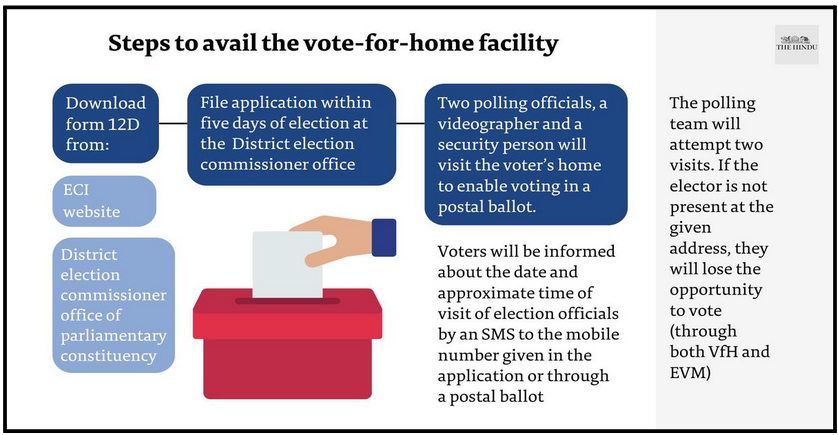GS Paper II
News Excerpt:
The Election Commission of India (ECI) has announced that media persons covering "polling day activities" are now eligible to vote in the upcoming Lok Sabha elections 2024 and state Assembly polls through postal ballots.
What are Postal Ballots?
- Postal ballots, also known as mail-in ballots, allow registered voters to cast their votes by mail instead of physically going to a polling station.
- This system serves as a convenient alternative for individuals unable to vote in person due to various circumstances, such as being away from their home constituency, facing a disability, or performing essential services on election day.
Who is eligible to cast their vote through postal ballots?
These are the eligible electors who can opt to vote through postal ballots:
- Service voters: Members of the armed forces, paramilitary forces, and government employees deployed on election duty far from their home constituencies.
- Absentee voters: Individuals unable to vote in person due to reasons like work commitments, illness, or disability. For example, In October 2019, the Ministry of Law and Justice amended the Conduct of Election Rules, 1961, lowered the age from 85 to 80 (for senior citizens) and allowed Persons with Disabilities (PwDs) to cast votes through postal ballots in the 2020 Delhi Assembly polls.

- Electors on election duty: Government officials and polling staff assigned duties at polling stations other than their own.
- Electors under preventive detention: Individuals detained under preventive custody orders during the election period.
- Essential services covering polling day activities: Media persons with authorization letters from the EC and those involved in essential services such as metros, railways, and healthcare have the option to vote using postal ballots in Lok Sabha and four state Assembly polls.
How to apply for a postal ballot
- To apply for a postal ballot, eligible voters must apply, Form 12 D, to the returning officer (RO) of their respective constituency.
- The application typically requires personal details, voter identification information, and the reason for seeking a postal ballot.
- The RO verifies eligibility and issues the postal ballot if the criteria are met.

- For service voters, the RO sends the postal ballot paper through the record office, directly or through the Ministry of External Affairs for service voters serving outside India.
- For senior citizens, a team of two polling officials, a videographer, and security personnel will visit the residence of the elector to facilitate this process.
- Voters will be informed of the date and time of the officials visit via SMS.
What is the process of postal voting?
- Receiving the postal ballot: Once approved, the RO sends the postal ballot to the voter's registered address, including the ballot paper, declaration form, secrecy sleeve, and pre-paid return envelope.
- Marking the ballot: Voters mark their preferred candidate(s) on the ballot paper in the secrecy sleeve to ensure confidentiality.
- People with blindness or physical infirmity are allowed to nominate a companion and take their assistance while home voting.
- Completing the declaration form: Voters fill out the declaration form, providing their signature and other relevant details.
- Sealing the envelope: Voters seal the marked ballot paper and declaration form inside the secrecy sleeve and place it into the pre-paid return envelope.
- Returning the postal ballot: Voters affix the postage stamp and mail the return envelope to the designated address within the specified time.
Counting of postal ballots:
- Postal ballots are counted separately from votes cast at polling stations.
- On the designated counting day, postal ballots are collected by postal authorities and brought to the counting center.
- The RO and election officials scrutinize postal ballots for validity and integrity, adding valid ballots to the respective candidate's vote count.
What else has the ECI done for inclusive elections?
- The government is also experimenting with remote voting for domestic migrants, according to a December 2022 press release.
- The Multi Constituency Remote Electronic Voting Machine (RVM) would allow people who migrate within the country for employment and opportunity (almost 450 million, as per the latest 2011 census) to vote for their home constituencies from remote locations.
- Internal migrants face a string of challenges due to the transient nature of their life and livelihood.
- Many are reluctant to get themselves enrolled multiple times, unwilling to get names deleted from electoral rolls of home constituencies and facing an emotional disconnect with the places they migrate to.
- If implemented, “it can lead to a social transformation for the migrants and connect with their roots,” the government said.
- If a senior citizen or a person with disability chooses to go to the booth, the ECI has mandated officials to provide Assured Minimum Facilities (AMF) like ramps, wheelchairs, first aid and toilets at polling stations.
- Measures, new and old, are being highlighted, including provision of free transportation on poll day, appointment of State and District PwD icons, and Braille-enabled EVMs and EPICs.


